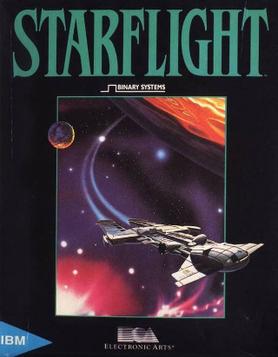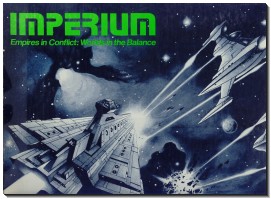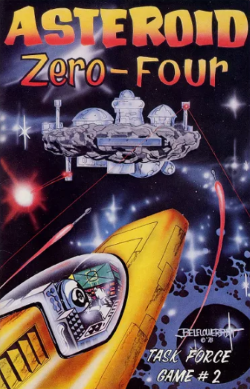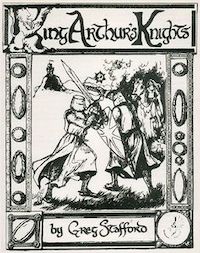Traveller is a science fiction role-playing game first published in 1977 by Game Designers' Workshop. Marc Miller designed Traveller with help from Frank Chadwick, John Harshman, and Loren Wiseman. Editions were published for GURPS, d20, and other role-playing game systems. From its origin and in the currently published systems, the game relied upon six-sided dice for random elements. Traveller has been featured in a few novels and at least two video games.

Master of Orion is a turn-based, 4X science fiction strategy game in which the player leads one of ten races to dominate the galaxy through a combination of diplomacy and conquest while developing technology, exploring and colonizing star systems.

Starflight is a space exploration, combat, and trading role-playing video game created by Binary Systems and published by Electronic Arts in 1986. Originally developed for IBM PC compatibles, it was later ported to the Amiga, Atari ST, Macintosh, and Commodore 64. A fully revamped version of the game was released for the Sega Genesis in 1991.

Cosmic Encounter is a science fiction–themed strategy board game designed by "Future Pastimes" and originally published by Eon Games in 1977. In it, each player takes the role of a particular alien species, each with a unique power to bend or break one of the rules of the game, trying to establish control over the universe. The game was inducted into the Academy of Adventure Gaming Arts & Design Adventure Gaming Hall of Fame in 1997.

Space Crusade is an adventure board game produced by Milton Bradley together with Games Workshop and was first made in 1990. It was produced in the UK and available in some other countries including Finland, Ireland, France, Spain, Denmark, Australia, Hellas and New Zealand. In Germany, Italy, Belgium and the Netherlands, it is known as Star Quest.

Triplanetary is a science fiction board wargame originally published by Game Designers' Workshop in 1973. The game is a simulation of space ship travel and combat within the Solar System in the early 21st Century.

Imperium is a science fiction board wargame designed by Marc W. Miller, and published in 1977 by the Conflict Game Company and Game Designers' Workshop (GDW). It features asymmetrical forces, the two sides having its unique set of constraints. The game came in a cardboard box illustrated with a space battle on the exterior. It included a cardboard-mounted, folding map of a local region of the Milky Way galaxy, a set of rules and charts, and the 352 counters representing the various spacecraft, ground units, and markers, and a six-sided die. A second edition was published in 1990, a third in 2001, and the first edition republished in 2004.

Spelljammer: Pirates of Realmspace is a video game for MS-DOS released by Strategic Simulations in 1992. It is a Dungeons & Dragons PC video game using the Advanced Dungeons & Dragons, Second Edition rules, and the Spelljammer setting. Spelljammer was programmed and designed by Cybertech Systems.
Starfire is a board wargame simulating space warfare and empire building in the 23rd century, created by Stephen V. Cole in 1979.

Starfleet Orion is a 1978 science fiction strategy game written and published by Automated Simulations. It appears to be the first space-themed strategy game sold for microcomputer systems. The game was originally written in BASIC for the Commodore PET, but later ported to other early home computer platforms including the TRS-80 and Apple II. The game was something of a success, leading to a string of successes for the company, notably the major hit Temple of Apshai.

Stellar Conquest is a science fiction board game published by Metagaming Concepts in 1974.
Lego Mars Mission was a Lego subtheme to Lego Space that sold from 2007 to 2009. It is set on Mars and features astronauts, aliens, and high-tech machinery.

StarForce: Alpha Centauri, subtitled "Interstellar Conflict in the 25th Century", is a science fiction board game published by Simulations Publications Inc. (SPI) in 1974. It was the first mass-market science fiction board wargame, and was a best-seller for SPI.
Evochron Legends is an online science fiction game developed and published by Starwraith 3D Games for Microsoft Windows. It was released on February 5, 2009.

Double Star is a 1979 science fiction board wargame, designed by Marc Miller, and published by Game Designers' Workshop that simulates interplanetary warfare in a double-star solar system.

Asteroid Zero-Four is a science fiction board wargame published by Task Force Games in 1979.

Godsfire is a science fiction board wargame published by Metagaming Concepts in 1976 that simulates planetary empire building, economics, and diplomacy. The game was reissued by Task Force Games in 1985.

Black Hole is a science fiction board wargame published by Metagaming Concepts in 1978 as part of its MicroGame line.

King Arthur's Knights is an Arthurian board game published by Chaosium in 1978 in which knights of the Round Table perform chivalrous quests for artifacts and treasure.
Pellic Quest was a computer-moderated science fiction play-by-mail (PBM) game appearing as early as 1978. Conflict Interaction Associates published it as a spinoff of Flying Buffalo's game Starweb. In the game, 10–15 players competed to dominate a universe strewn with artifacts left by a super-race, the Pellics. Players role-played one of six character types with options to develop their position, expand through conquest, conduct diplomacy, and other actions. The game received generally positive reviews in gaming magazines in the late 1970s and early 1980s. The publisher appeared to close the game by 1988.















